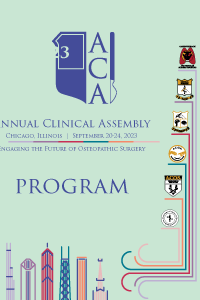General Surgery
BMI’s Effect on Surgical Site Occurrences Following Robotic Abdominal Wall Reconstruction with Poly-4-hydroxybutyrate Mesh for Ventral Hernia Repair

Alexandra C. Skoczek, MPH, MS-IV (she/her/hers)
Medical Student
Edward Via College of Osteopathic Medicine - Auburn
Edward Via College of Osteopathic Medicine - Auburn
Huntsville, AL, United States
Primary Presenter(s)
BMI’s greater than >40 kg/m2 have previously been reported to increase the risk of surgical site occurrences (SSOs) after gastrointestinal surgery, including hernia repair. Newer studies, however, have begun to show lower rates of SSOs in obese patients when using minimally invasive surgical techniques. This study aimed to analyze the effects of obesity on SSO following robotic abdominal wall reconstruction (AWR) using the transversus abdominis release (TAR) procedure with Poly-4-hydroxybutyrate (P4HB) resorbable biosynthetic mesh underlay for elective ventral hernia repair.
Methods or Case Description:
A retrospective review of medical records for patients who underwent robotic AWR for ventral hernia repair between 2015 and 2022 performed by a single surgeon was conducted. Patients were separated into 5 groups: underweight (BMI < 18.5 kg/m2), healthy (BMI ≥ 18.5 and < 25 kg/m2), overweight (BMI ≥ 25 and < 30 kg/m2), obese (BMI ≥ 30 and < 40 kg/m2), and morbidly obese (BMI ≥ 40 kg/m2). Rates of SSO (seroma, cellulitis, and abscess) were then compared between groups.
Outcomes:
334 subjects met the inclusion criteria for analysis. 0.29% were underweight, 7.6% were of healthy BMI, 21.2% were overweight, 51.4% were obese, and 19.5% were morbidly obese. 4.4% of patients experienced a SSO within 60 days post-operation with no significant difference seen between the 5 groups (P = 0.68). None of the four groups with SSOs (healthy, overweight, obese, or morbidly obese) showed statistically significant increased odds of SSO; healthy (odds ratio 0.979, 95% CI 0.039 – 5.24, P = 0.98), overweight (odds ratio 0.289, 95% CI 0.012 – 1.48, P = 0.21), obese (odds ratio 1.42, 95% CI .49 – 4.42, P = 0.49), and morbidly obese (odds ratio 1.57, 95% CI .41 – 4.84, P = 0.48).
Conclusion:
No significant difference in SSO rates was seen between different BMI’s and elevated BMI was not seen to significantly increase the odds of SSO following robotic AWR with P4HB mesh. This suggests robotic AWR with P4HB mesh may be a reliable surgical technique in obese patients to minimize post operative complications. However, this study was limited in sample size and did not compare different surgical techniques. Future studies with a larger population and a variety of techniques will be needed to evaluate if robotic hernia repairs with this technique is the preferred method when compared to open and laparoscopic methods.

